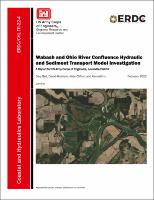Please use this identifier to cite or link to this item:
https://hdl.handle.net/11681/43441Full metadata record
| DC Field | Value | Language |
|---|---|---|
| dc.contributor.author | Bell, Gary L. | - |
| dc.contributor.author | Abraham, David D. | - |
| dc.contributor.author | Clifton, Nathan D. | - |
| dc.contributor.author | Lamkin, Kenneth H. | - |
| dc.creator | Coastal and Hydraulics Laboratory (U.S.) | - |
| dc.date.accessioned | 2022-03-02T15:22:57Z | - |
| dc.date.available | 2022-03-02T15:22:57Z | - |
| dc.date.issued | 2022-02 | - |
| dc.identifier.govdoc | ERDC/CHL TR-22-4 | - |
| dc.identifier.uri | https://hdl.handle.net/11681/43441 | - |
| dc.identifier.uri | http://dx.doi.org/10.21079/11681/43441 | - |
| dc.description | Technical Report | en_US |
| dc.description.abstract | Avulsions of the Wabash River in 2008 through 2011 at its confluence with the Ohio River resulted in significant shoaling in the Ohio River. This caused a re-alignment of the navigation channel and the need for frequent dredging. A two-dimensional numerical hydrodynamic model, Adaptive Hydraulics (AdH), was developed to simulate base (existing) conditions and then altered to simulate multiple alternative scenarios to address these sediment issues. The study was conducted in two phases, Phase 1 in 2013 – 2015 and Phase 2 in 2018 – 2020. Field data were collected and consisted of multi-beam bathymetric elevations, bed sediment samples, suspended sediment samples, and discharge and velocity measurements. The model hydrodynamic and sediment transport computations adequately replicated the water surface slope, flow splits, bed sediment gradations, and suspended sediment concentrations when compared with field data. Thus, it was shown to be dependable as a predictive tool. The alternative that produced the most desirable results included a combination of three level-crested emergent dikes on Wabash Island and four submerged dikes on the Illinois shore with a level crest from the bank to the tip of the dike. The selected alternative produced an improved sailing line while maintaining authorized channel depths. | en_US |
| dc.description.sponsorship | United States. Army. Corps of Engineers. Louisville District. | en_US |
| dc.description.tableofcontents | Abstract .................................................................................................................................... iv Figures and Tables .................................................................................................................. vi Preface ................................................................................................................................... viii 1 Introduction ...................................................................................................................... 1 1.1 Background ........................................................................................................ 1 1.2 Objective ............................................................................................................ 2 1.3 Approach ............................................................................................................ 2 1.4 Site description .................................................................................................. 3 2 Model Development and Calibration ............................................................................. 6 2.1 Numerical model code description ................................................................... 6 2.2 Model development ........................................................................................... 6 2.3 Phase 1 model ................................................................................................... 7 2.4 Phase 2 model ................................................................................................ 12 2.4.1 Phase 2 data collection ............................................................................................ 12 2.4.2 Phase 2 model and hydraulic validation ................................................................. 13 2.5 Phase 2 model sediment validation ............................................................... 21 3 Phase 2 Model Simulations and Results .................................................................... 28 3.1 Alternative simulations ................................................................................... 28 3.2 Model boundary conditions and simulations ............................................... 33 3.3 Model results showing navigable water extents ........................................... 35 4 Summary ......................................................................................................................... 43 References ............................................................................................................................. 45 Appendix A: Wentworth References ................................................................................... 46 Appendix B: Suspended Sediment Comparison for Ranges 1, 2, and 4 ....................... 48 Unit Conversion Factors ....................................................................................................... 50 Acronyms and Abbreviations ............................................................................................... 51 Report Documentation Page | - |
| dc.format.extent | 60 pages / 15.79 MB | - |
| dc.format.medium | - | |
| dc.language.iso | en_US | en_US |
| dc.publisher | Engineer Research and Development Center (U.S.) | en_US |
| dc.relation.ispartofseries | Technical Report (Engineer Research and Development Center (U.S.)) ; no. ERDC/CHL TR-22-4 | - |
| dc.rights | Approved for Public Release; Distribution is Unlimited | - |
| dc.source | This Digital Resource was created in Microsoft Word and Adobe Acrobat | - |
| dc.subject | Confluence | en_US |
| dc.subject | Hydraulic models | en_US |
| dc.subject | Ohio River | en_US |
| dc.subject | Sedimentation and depostition | en_US |
| dc.subject | Sediment transport | en_US |
| dc.subject | Wabash River | en_US |
| dc.title | Wabash and Ohio River confluence hydraulic and sediment transport model investigation : a report for US Army Corps of Engineers, Louisville District | en_US |
| dc.type | Report | en_US |
| Appears in Collections: | Technical Report | |
Files in This Item:
| File | Description | Size | Format | |
|---|---|---|---|---|
| ERDC-CHL TR-22-4.pdf | 15.79 MB | Adobe PDF |  View/Open |